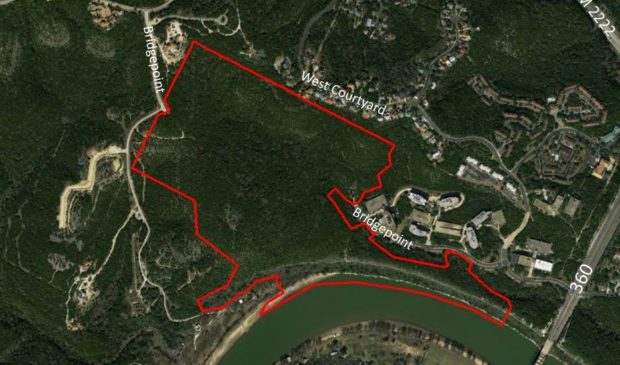Camelback project narrowly receives Environmental Commission’s approval
Monday, September 24, 2018 by
Jessi Devenyns After nearly four and a half hours of testimony and discussion, and two votes due to some confusion over the conditions attached to a motion, the Environmental Commission endorsed the environmental superiority of the Camelback PUD, the controversial planned unit development on a 145-acre plot of land that fronts Lake Austin just west of Loop 360.
After a narrow 5-4 vote that would leave the project without a recommendation or the associated environmental conditions, the commissioners agreed to reconsider the vote. On the second try, the project passed with a 7-2 margin to recommend its approval.
The commissioners generally agreed on the superiority of the proposed PUD in comparison to the 1987 PUD when they looked at the plan for clustered development and the donation of 26.11 acres of parkland to the city. A sticky situation arose, however, when it came to the method with which people would access the lakeside clubhouse and dock.
According to Chair Linda Guerrero, many of the plans are still “half baked” with no renderings or engineering studies to provide data.
Part of the reason for this rushed approval is the compressed timeline necessitated by the purchase of nearby Champion tract 3, whose current development proposal has generated traffic concerns among the neighborhood. Jonathan Coon, the Camelback developer, has said he is interested in buying the Champion parcel from the current owners and pursuing a less intense development at the behest of the neighbors. “We only agreed to purchase Champion tract 3 because of so much community interest,” Coon told the Austin Monitor.
The option period for this tract extends until Nov. 2, and the final Council hearing on the Camelback project is scheduled for Nov. 1. Although technically separate, the two projects are not mutually exclusive. Coon explained to the Monitor that he is happy to develop the Champion tract with less dense development, but the result will be a loss in value. He agreed to pursue this approach on the condition that the Camelback project is approved because “we will recover that value over at Camelback.”
Indeed, this entire project is a “horse trade,” according to city Environmental Officer Chris Herrington. However, Herrington noted that Coon has made significant concessions on behalf of the environment. “I would be comfortable recommending overall superiority,” he said.
Two major changes were the removal of an office park in favor of more green space and the extension of the dock by 40 feet (the dock will still be 30 feet long) in order to accommodate the rehabilitation of the shoreline wetland.
The dock, which has generated a lot of contention, is within code specifications. It is 20 percent of the shoreline that includes the portion of the tract that Coon is donating as parkland. Although several commissioners thought that would set a precedent, Herrington argued that it was justified by the fact that the city would be adding its first park along Lake Austin in 35 years, and it will be maintained by Coon.
The fee in lieu for this park if not donated would only be $63,000, according to Coon.
Similarly, the proposed tram to descend the cliff face to reach the private clubhouse and dock also caused a stir. Although an hour’s worth of public input was fairly divided between those for and those against the project, much of the loudest opposition was directed at the proposed tram. Tom Burns, who spoke on behalf of the Bunny Run neighborhood that Bill Nalle has been representing over the past few months, told the Monitor that despite the neighborhood’s unwavering opposition to the idea of the extensive dock and the tramway that is required to reach it, “We are in favor of (the project). We know and understand the wholesale economics of it.”
Although many understood the economic reasons behind the dock and the associated tramway, there was still fear associated with the safety of cliffside mechanized access.
Commissioner Pam Thompson expressed her inability to “justify putting people below where boulders the size of SUVs have been seen to fall. … That’s quite concerning,” she said.
City staff recommended constructing an elevator instead of using a tram, which are known to be destructive to vegetation and rimrock. Even the idea of constructing stairs caused controversy. In light of the choices presented, Herrington suggested that regardless of if an elevator or tram is chosen, “I think we could apply conditions to either one.”
Jeff Howard, the attorney for the developer, assured the commissioners that already the project team has decided that “whatever mechanical access we have, it (will not be) bolted into the cliff face.”
In the end, the commission voted to recommend the superiority of the plan over the current 1987 PUD, but only with a host of attached conditions. Commissioners Pam Thompson and Peggy Maceo voted against the recommendation.
To offer some reassurance, Commissioner Hank Smith reminded those in the room, “I think this is going to continue to change up until 10 minutes before City Council approves the item.”
The Camelback PUD project will go before the Zoning and Platting Commission on Oct. 2.
This story has been updated.
The Austin Monitor’s work is made possible by donations from the community. Though our reporting covers donors from time to time, we are careful to keep business and editorial efforts separate while maintaining transparency. A complete list of donors is available here, and our code of ethics is explained here.
You're a community leader
And we’re honored you look to us for serious, in-depth news. You know a strong community needs local and dedicated watchdog reporting. We’re here for you and that won’t change. Now will you take the powerful next step and support our nonprofit news organization?









